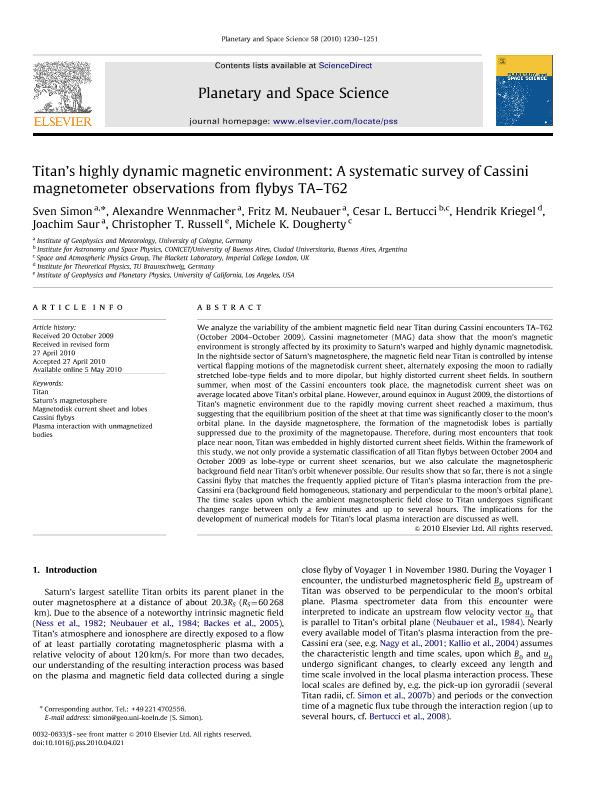Mostrar el registro sencillo del ítem
dc.contributor.author
Simon, Sven
dc.contributor.author
Wennmacher, Alexandre
dc.contributor.author
Neubauer, Fritz M.
dc.contributor.author
Bertucci, Cesar

dc.contributor.author
Kriegel, Hendrik
dc.contributor.author
Saur, Joachim
dc.contributor.author
Russell, Christopher T.
dc.contributor.author
Dougherty, Michele K.
dc.date.available
2017-07-11T19:42:47Z
dc.date.issued
2010-08
dc.identifier.citation
Simon, Sven; Wennmacher, Alexandre; Neubauer, Fritz M.; Bertucci, Cesar; Kriegel, Hendrik; et al.; Titan's highly dynamic magnetic environment: A systematic survey of Cassini magnetometer observations from flybys TA-T62; Elsevier; Planetary and Space Science; 58; 10; 8-2010; 1230-1251
dc.identifier.issn
0032-0633
dc.identifier.uri
http://hdl.handle.net/11336/20156
dc.description.abstract
We analyze the variability of the ambient magnetic field near Titan during Cassini encounters TA–T62 (October 2004–October 2009). Cassini magnetometer (MAG) data show that the moon's magnetic environment is strongly affected by its proximity to Saturn's warped and highly dynamic magnetodisk. In the nightside sector of Saturn's magnetosphere, the magnetic field near Titan is controlled by intense vertical flapping motions of the magnetodisk current sheet, alternately exposing the moon to radially stretched lobe-type fields and to more dipolar, but highly distorted current sheet fields. In southern summer, when most of the Cassini encounters took place, the magnetodisk current sheet was on average located above Titan's orbital plane. However, around equinox in August 2009, the distortions of Titan's magnetic environment due to the rapidly moving current sheet reached a maximum, thus suggesting that the equilibrium position of the sheet at that time was significantly closer to the moon's orbital plane. In the dayside magnetosphere, the formation of the magnetodisk lobes is partially suppressed due to the proximity of the magnetopause. Therefore, during most encounters that took place near noon, Titan was embedded in highly distorted current sheet fields. Within the framework of this study, we not only provide a systematic classification of all Titan flybys between October 2004 and October 2009 as lobe-type or current sheet scenarios, but we also calculate the magnetospheric background field near Titan's orbit whenever possible. Our results show that so far, there is not a single Cassini flyby that matches the frequently applied picture of Titan's plasma interaction from the pre-Cassini era (background field homogeneous, stationary and perpendicular to the moon's orbital plane). The time scales upon which the ambient magnetospheric field close to Titan undergoes significant changes range between only a few minutes and up to several hours. The implications for the development of numerical models for Titan's local plasma interaction are discussed as well.
dc.format
application/pdf
dc.language.iso
eng
dc.publisher
Elsevier

dc.rights
info:eu-repo/semantics/openAccess
dc.rights.uri
https://creativecommons.org/licenses/by-nc-sa/2.5/ar/
dc.subject
Titan
dc.subject
Saturn'S Magnetosphere
dc.subject
Magnetodisk Current Sheet And Lobes
dc.subject
Plasma Interaction with Unmagnetized Bodies
dc.subject.classification
Astronomía

dc.subject.classification
Ciencias Físicas

dc.subject.classification
CIENCIAS NATURALES Y EXACTAS

dc.title
Titan's highly dynamic magnetic environment: A systematic survey of Cassini magnetometer observations from flybys TA-T62
dc.type
info:eu-repo/semantics/article
dc.type
info:ar-repo/semantics/artículo
dc.type
info:eu-repo/semantics/publishedVersion
dc.date.updated
2017-07-11T13:11:11Z
dc.journal.volume
58
dc.journal.number
10
dc.journal.pagination
1230-1251
dc.journal.pais
Reino Unido

dc.journal.ciudad
Londres
dc.description.fil
Fil: Simon, Sven. University of Cologne; Alemania
dc.description.fil
Fil: Wennmacher, Alexandre. University of Cologne; Alemania
dc.description.fil
Fil: Neubauer, Fritz M.. University of Cologne; Alemania
dc.description.fil
Fil: Bertucci, Cesar. Consejo Nacional de Investigaciónes Científicas y Técnicas. Oficina de Coordinación Administrativa Ciudad Universitaria. Instituto de Astronomía y Física del Espacio. - Universidad de Buenos Aires. Facultad de Ciencias Exactas y Naturales. Instituto de Astronomía y Física del Espacio; Argentina
dc.description.fil
Fil: Kriegel, Hendrik. University of California; Estados Unidos
dc.description.fil
Fil: Saur, Joachim. University of Cologne; Alemania
dc.description.fil
Fil: Russell, Christopher T.. University of California; Estados Unidos
dc.description.fil
Fil: Dougherty, Michele K.. Imperial College London; Reino Unido
dc.journal.title
Planetary and Space Science

dc.relation.alternativeid
info:eu-repo/semantics/altIdentifier/doi/http://dx.doi.org/10.1016/j.pss.2010.04.021
dc.relation.alternativeid
info:eu-repo/semantics/altIdentifier/url/http://www.sciencedirect.com/science/article/pii/S0032063310001339
Archivos asociados
